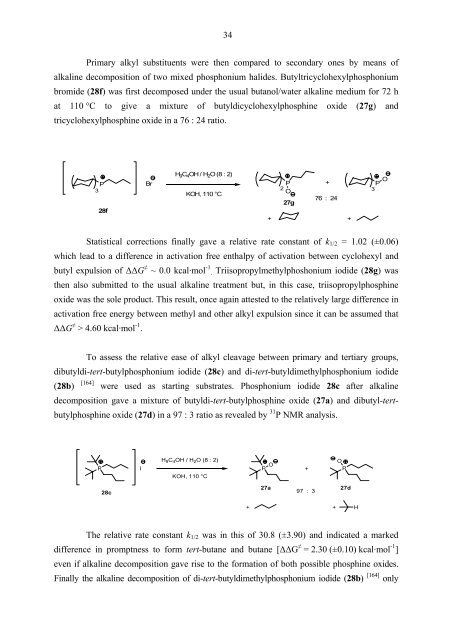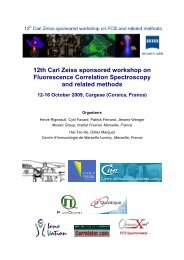My PhD dissertation - Institut Fresnel
My PhD dissertation - Institut Fresnel
My PhD dissertation - Institut Fresnel
Create successful ePaper yourself
Turn your PDF publications into a flip-book with our unique Google optimized e-Paper software.
34<br />
Primary alkyl substituents were then compared to secondary ones by means of<br />
alkaline decomposition of two mixed phosphonium halides. Butyltricyclohexylphosphonium<br />
bromide (28f) was first decomposed under the usual butanol/water alkaline medium for 72 h<br />
at 110 °C to give a mixture of butyldicyclohexylphosphine oxide (27g) and<br />
tricyclohexylphosphine oxide in a 76 : 24 ratio.<br />
P<br />
3<br />
28f<br />
H 9C 4OH / H 2O (8 : 2)<br />
Br<br />
KOH, 110 °C<br />
P<br />
2<br />
O<br />
27g<br />
+<br />
76 : 24<br />
+ +<br />
Statistical corrections finally gave a relative rate constant of k1/2 = 1.02 (±0.06)<br />
which lead to a difference in activation free enthalpy of activation between cyclohexyl and<br />
butyl expulsion of ∆∆G ≠ ~ 0.0 kcal·mol -1 . Triisopropylmethylphoshonium iodide (28g) was<br />
then also submitted to the usual alkaline treatment but, in this case, triisopropylphosphine<br />
oxide was the sole product. This result, once again attested to the relatively large difference in<br />
activation free energy between methyl and other alkyl expulsion since it can be assumed that<br />
∆∆G ≠ > 4.60 kcal·mol -1 .<br />
To assess the relative ease of alkyl cleavage between primary and tertiary groups,<br />
dibutyldi-tert-butylphosphonium iodide (28c) and di-tert-butyldimethylphosphonium iodide<br />
(28b) [164] were used as starting substrates. Phosphonium iodide 28c after alkaline<br />
decomposition gave a mixture of butyldi-tert-butylphosphine oxide (27a) and dibutyl-tert-<br />
butylphosphine oxide (27d) in a 97 : 3 ratio as revealed by 31 P NMR analysis.<br />
P I P O<br />
H9C4OH / H2O (8 : 2)<br />
28c<br />
KOH, 110 °C<br />
O<br />
P<br />
27a 27d<br />
97 : 3<br />
+ +<br />
The relative rate constant k1/2 was in this of 30.8 (±3.90) and indicated a marked<br />
difference in promptness to form tert-butane and butane [∆∆G ≠ = 2.30 (±0.10) kcal·mol -1 ]<br />
even if alkaline decomposition gave rise to the formation of both possible phosphine oxides.<br />
Finally the alkaline decomposition of di-tert-butyldimethylphosphonium iodide (28b) [164] only<br />
+<br />
H<br />
P<br />
3<br />
O













